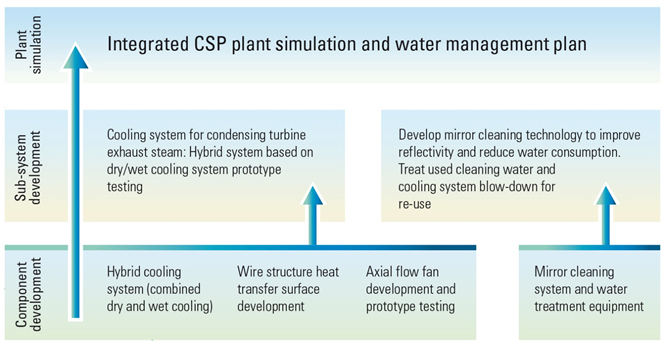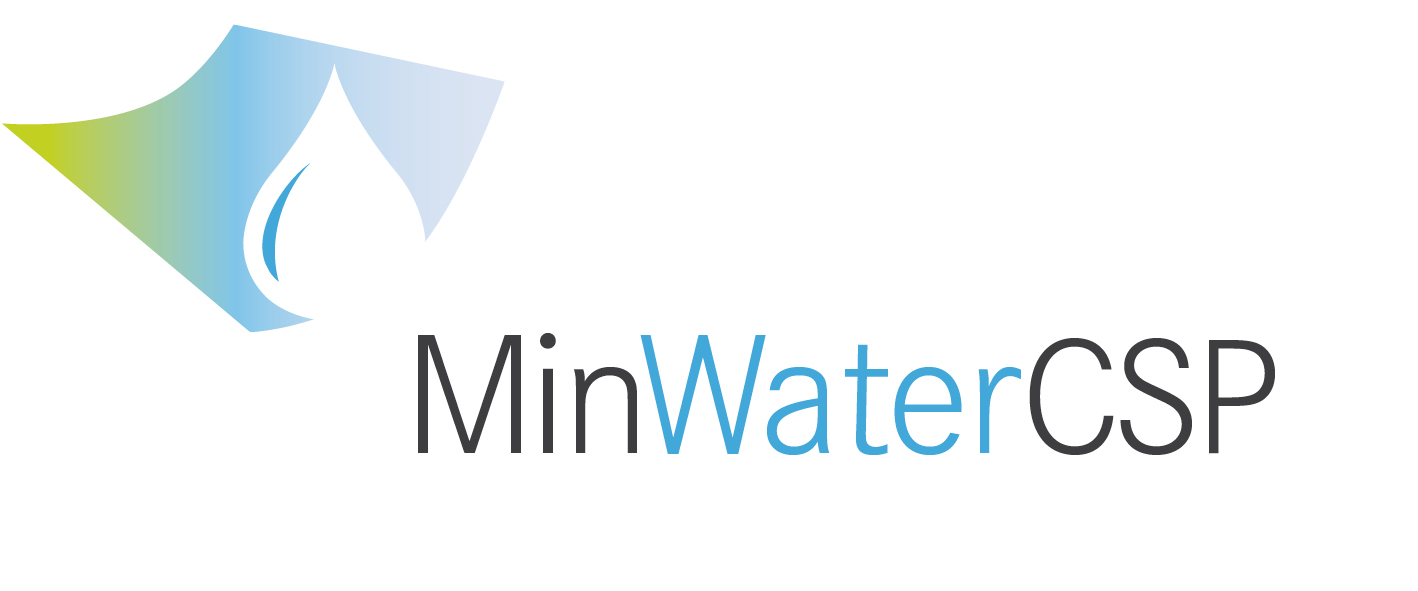
Summary of work
![]()
The work plan of MinWaterCSP is based on 11 work packages and spans a period of 3 years. Three work packages are dedicated to project management, communication, dissemination and exploitation. Seven work packages cover the development of the various technologies in question, while technical integration and overall plant simulation is dealt with a further work package. A brief outline of the work packages is as follows together with the work already performed:
Project management:
Work package 1 focuses on project management and technical coordination activities as well as various administrative tasks which are necessary for successful project execution.
Work performed: With regard to policy impact a first step has been done with awareness raising of national and legislative bodies at events, workshops and bilateral meetings. Partners have discussed in terms of market transformation about the exploitation potential of their project results and are well aware of other partners´ exploitation and ownership claims.
Cooling technology development:
Work package 2 deals with advanced thermal design of wet/dry cooling systems for dedicated use in CSP applications. Work packages 3 covers axial flow fan development while work package 4 contains the advanced heat transfer surface development.
Work performed in work package 2: The hybrid dry/wet cooling system and its’ thermal sizing is part of work package 2 (Hybrid cooling system design) and was carried out with a newly developed software, followed by the detailed structural, ducting, piping and heat exchanger design. Equations for cooling system performance prediction had been prepared for the “ColSim”-Program which is major part in work package 9. For the hybrid dry/wet cooling system the environmental impact leads to less strain on local water resources and increased water availability for human consumption.
Work performed in work package 3: Work packages 3 and 8 (Axial flow fan design and manufacture) started with the design and manufacturing of a reference fan, installed at the Eskom Matimba ACC site, South Africa. Tests showed that the Reference Fan adheres to the performance and structural requirements for the typical air-cooled condenser installation. Three prototype fans were designed and evaluated for performance and noise, using computational fluid dynamics (CFD). Based on this evaluation it was decided to continue manufacturing a 24 ft. diameter version of the respective fan.
A number of improvement options of the cooling fan drive efficiency are currently under development, i.e. a magnetic gearbox, a wound rotor motor and a written pole motor. With regard to the axial fan development the tests showed a potential reduction in fan power consumption with a direct impact on the profitability of CSP plant operation and its’ life-cycle. The magnetic gearbox has the potential to reduce the required fan drive size, thereby impacting the capital cost requirements of CSP plants. The magnetic gear drive also has the potential to reduce maintenance costs of the mechanical equipment.
Work performed in work package 4: In work package 4 (Wire surface heat exchanger) a CFD comparison of the simulated performance of a wire structure heat exchanger with a reference air-cooled condenser of a CSP plant in Morocco shows a decrease in total mass of the heat exchanger of up to 10% at equal thermal and fluid dynamic performance. The implementation of the manufacturing procedure of the textile wire structured heat exchanger is still ongoing. The novel wire based heat exchanger concept has – compared to conventional solutions – a potential saving of 10% material and a reduction in life-cycle environmental impact, which can lower investment cost of cooling systems used in CSP plants.
Water treatment and handling development:
Mirror cleaning technology development is covered in work package 5 and water treatment and integrated water management is dealt with in work package 6.
Work performed in work package 5: The main results covered in work package 5 (Solar collector cleaning) had been the design and construction of different cleaning prototypes – truck-based for parabolic troughs and heliostats and a new robot for Fresnel collector applications. Furthermore collector reflectance monitoring prototypes had been developed and the collection of data from the solar field has started, i.e. mapping and measurement of soiling rates. For the cleaning process a reduction of 25% of the previous water consumption seems achievable with a clear impact in the operation costs for contractors and the most appreciable value in the saving in arid zones.
Work performed in work package 6: The water management approaches in work package 6 (Water use and treatment) are based on a literature study and discussions with CSP plant operators. Simulation models for the water consumption had been developed and were implemented into the simulation software “ColSim”. Modular treatment subsystems have been defined as a solution for CSP-water treatment and management. From the developed Geographic Information System (GIS) method we expect that this method will become a benchmark for any site or environmental impact assessment study of CSP plants. In terms of environment, a better understanding on water quality requirements for optimal CSP plants cooling will allow the optimization of water usage – in particular for areas with scarce water resources – and potentially reduce the usage of chemicals for cleaning.
Testing and demonstration:
Work packages 7 and 8 focus on the test facility design, construction, commissioning and testing activities at the demonstration sites. This includes advanced fan and cooling system functional testing as well as mirror cleaning demonstration activities.
Work performed in work package 7: In work package 7 (Cooling system fouling tests) the test rig had been successfully commissioned and the experiments with representative water qualities und typical operating conditions are still ongoing.
Work performed in work package 8: In work package 8 (full scale cooling and fan test) the team had to design, build and validate a novel test facility for the hybrid cooling system and the CSP cooling fan. The structure and process design had been finalized, the manufacturing drawings were prepared and the procurement process and civil work has started.
CSP plant simulation:
Work package 9 is the technology integration and CSP plant simulation activity.
Work performed: In work package 9 (CSP plant system simulation) detailed “ColSim” performance models for various CSP technologies were developed. All water and wastewater streams throughout the CSP plant were added to the software, enabling the simulation of water consumption, water quality, treatment processes and the required energy for treatment. The developed detailed simulation software ColSim will be a benchmark for CSP plants’ life-cycle performance and water foot-print assessments.
Administration and application:
Work packages 10 and 11 focus in communication, dissemination and exploitation.
Work performed in work package 10: The communication and dissemination activities (work package 10) aim to create wide visibility and acceptance of the further developed CSP technologies. So far all in all approximately 19,000 stakeholders and/or individuals have been reached through various channels of communication.
Work performed in work package 11: The Exploitation activities (work package 11) supporta project partners in developing long term strategies in order to turn the developed technologies to economic added value. Two exploitation workshops and several webinars within the consortium took place where partners identified together project results, exploitable results, background, ownership and exploitation claims.






